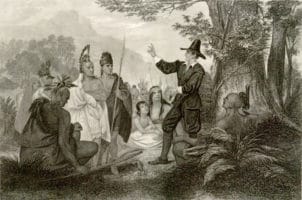
5 Johns in the Colonies
Many “Johns” helped spread the gospel in colonial New England. On this episode of 5 Minutes in Church History, Dr. Stephen Nichols introduces us to John Eliot, John Davenport, John Tennent, John Brainerd, and John Wauwaumpequunnaunt.
I’m sure you know someone named John. They’re all over, aren’t they, these Johns. We have them in the New Testament, and we have them all throughout church history. In fact, it was six Johns that wrote the Scots Confession. But I want to talk to you about five Johns: five men named John in the New England colonies.
 The first that we come to is John Eliot. He was born in 1604 in old England and died in New England in 1690. He studied at Cambridge with Thomas Hooker and then he moved to Boston. In 1631, he began a ministry and a church at Roxbury, and he began to turn his attention to the Algonquin Indians. Of course, his name is associated with the first Bible that was published in America, which was a translation of the Bible into the Algonquin language.
The first that we come to is John Eliot. He was born in 1604 in old England and died in New England in 1690. He studied at Cambridge with Thomas Hooker and then he moved to Boston. In 1631, he began a ministry and a church at Roxbury, and he began to turn his attention to the Algonquin Indians. Of course, his name is associated with the first Bible that was published in America, which was a translation of the Bible into the Algonquin language.
He died at the age of eighty-five, which was a very old age for folks who lived in the seventeenth-century. On his deathbed, he’s reported to have said, “Welcome, joy!” That’s the first John.
The second John is John Davenport. He was born in 1597 and died in 1670. He was the founder of the New Haven colony. He went from old England to Holland, eventually made his way to Boston, and finally made his way to New Haven, Connecticut. Just as there was Harvard College for the colony of Massachusetts, he had a dream of founding a college for the colony of Connecticut. That dream would come to fruition after his death, and that would be Yale College, founded in 1701.
Another John of the colonies is John Tennent. He has a famous father, William, and a famous brother, Gilbert. He was born in 1707 and died in 1732. He was trained in Neshaminy at the Log College, which was the college that his father had set up. The Log College in Neshaminy, Pennsylvania crossed over the Delaware River and, eventually, became the Log College of New Jersey, which eventually became Princeton University.
He went on to serve in a Presbyterian church. To give you a little insight into John Tennent, he spent four days agonizing over his sin before he was converted. However, his life after his conversion was full of joy that far surpassed those four days of agony. That’s John Tennent, our third John.
The fourth John is John Brainerd. Now, you’ve probably heard of his brother, David Brainerd. David Brainerd, of course, was the missionary to the Delaware Indians and to the Susquehanna Indians in Pennsylvania and New Jersey. He was a missionary to these Indians for two years, and we know a lot about David Brainerd. But here we have his brother, John Brainerd, who was a missionary to the Indians for a far longer time. He established a school during his missionary work, and for a long time, he was a trustee of Princeton College. He at one time had a circuit of seven churches that he preached in, among these were what was called “praying Indians,” who converted Native Americans to Christianity.
Well, that brings us to our fifth and final John. Now, his English name is John, but he was actually a Mahican Indian named “Wauwaumpequunaunt,” but they simply called him John. He was a translator for yet another John, John Sergeant, who founded the mission work there in Stockbridge, Massachusetts. When Jonathan Edwards was kicked out of his church in Northampton, Massachusetts and went to Stockbridge in 1751, John Wauwaumpequunaunt served as his translator as well.
There you have it, the five Johns of colonial New England.
Stay connected with 5 Minutes in Church History by getting the weekly podcast on iTunes, SoundCloud, or via RSS. You can also subscribe to the blog via RSS and follow us on Twitter and Facebook.
(This podcast is by Ligonier Ministries. Discovered by Christian Podcast Central and our community — copyright is owned by the publisher, not Christian Podcast Central, and audio is streamed directly from their servers.)